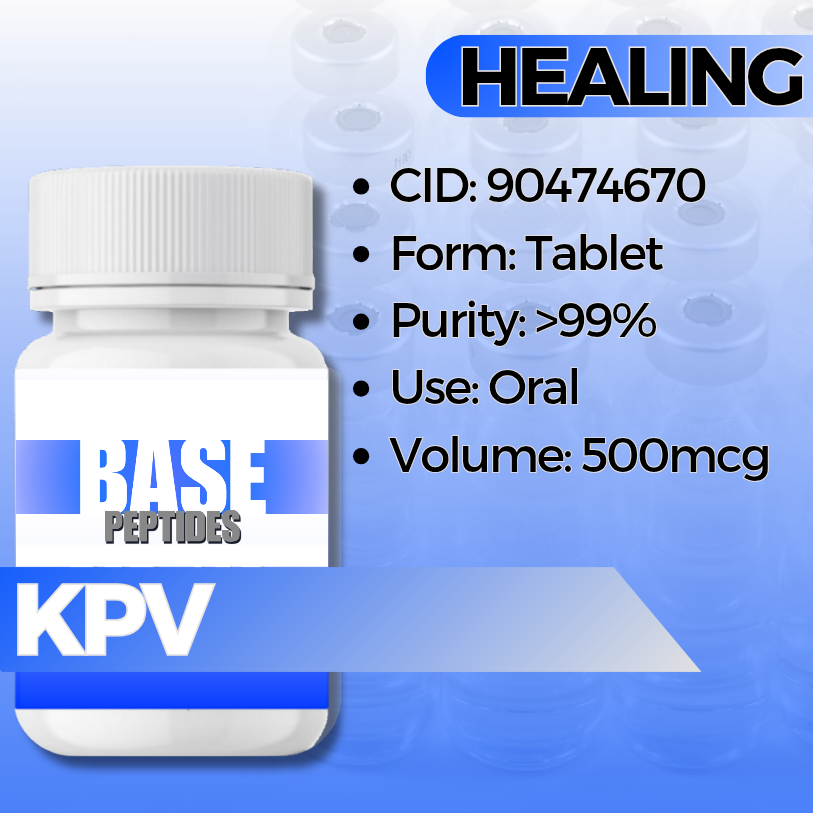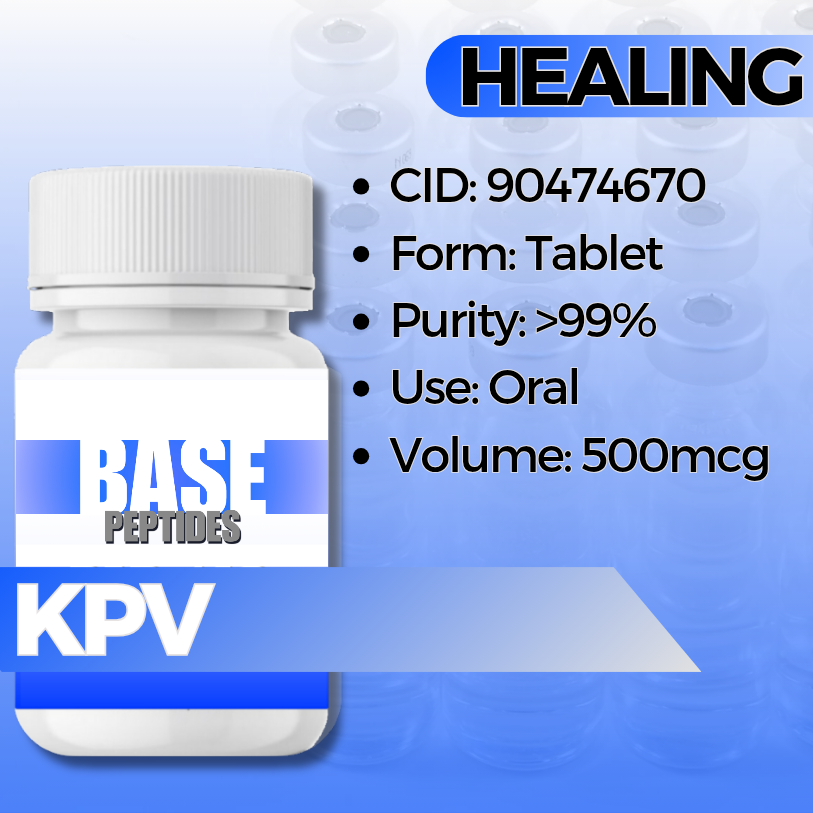KPV Tablets 500mcg
KPV Tablets 500mcg
Base Peptides are intended for licensed medical professionals and experienced researchers. Reconstitution required. Dosing and use instructions are not provided.
Regular price
$150.00
Regular price
Sale price
$150.00
Shipping calculated at checkout.
Quantity
Couldn't load pickup availability
KPV — α-MSH C-terminal Tripeptide (Lys-Pro-Val)
KPV is the minimal Lys-Pro-Val sequence from the C-terminus of α-melanocyte-stimulating hormone (α-MSH). It’s widely used to study innate immune signaling, epithelial barrier biology, and anti-inflammatory pathways in gut and skin models.
Identifiers
- Core sequence: Lys–Pro–Val (KPV)
- Common synonyms: α-MSH(11–13), ACTH(11–13)
- Representative CAS (free tripeptide): 67727-97-3
- Representative CAS (Ac-KPV-NH2): 112965-21-6 (acetylated, amidated research form)
- PubChem (example): CID 145457641 (tripeptide; form-dependent), CID 125672 (Ac-KPV-NH2) [
- Notes: Molecular formula/MW vary by salt and end-group (free tripeptide often reported ~342.4 Da; Ac-amidated ~≈384–386 Da).
How It Works (Plain English)
- KPV is studied as a compact melanocortin fragment that preserves α-MSH’s anti-inflammatory signals in several models.
- In the gut, KPV can be transported by PepT1 (a di/tri-peptide transporter) into epithelial and immune cells—important for intestinal research.
- In skin/epithelium, KPV is used to probe cytokine balance and barrier support without relying on classic cAMP responses.
Why Researchers Use It
- To model anti-inflammatory peptide signaling in intestinal and cutaneous systems.
- To study epithelial barrier function, cytokines, and chemokines in response to stressors.
- To compare minimal motif activity against longer melanocortin fragments.
Key Studies — What Was Tested, What Changed, Why It Matters
PepT1-mediated uptake & intestinal inflammation
- What was tested: Whether KPV enters gut epithelial/immune cells via PepT1 and affects colitis severity in rodent models.
- What changed: KPV uptake through PepT1 was demonstrated; oral KPV reduced DSS/TNBS colitis and pro-inflammatory cytokines.
- Why it matters: Supports use of KPV to study peptide-transporter biology and anti-inflammatory mechanisms in the intestine.
Melanocortin-fragment anti-inflammatory context
- What was reviewed: α-MSH and its short C-terminal fragments (including KPV) retain antimicrobial/anti-inflammatory activity across models.
- Why it matters: Provides a mechanistic backdrop for using minimal sequences to parse immune pathways without full hormone complexity.
Keratinocyte signaling nuance
- What was tested: cAMP signaling in human keratinocytes exposed to α-MSH, ACTH fragments, and KPV.
- What changed: No cAMP elevation detected under several conditions, suggesting non-canonical pathways in these cells.
- Why it matters: Encourages broad endpoints (cytokines, NF-κB/MAPK, barrier metrics) when studying KPV in skin models.
Potential Research Applications
Gut & Barrier Biology
- Intestinal epithelial transport (PepT1) & permeability assays
- Cytokine/chemokine panels in DSS/TNBS paradigms
Skin & Epithelial Models
- Inflammation and wound-closure assays
- NF-κB/MAPK pathway readouts under stress
Comparative Melanocortins
- KPV vs longer α-MSH fragments
- Minimal-motif mapping and SAR
Synergistic Peptides (for Study Design)
LL-37
- Why pair: Innate-defense peptide for epithelial repair and host-response studies alongside KPV.
- Angle: Barrier integrity + cytokine balance in co-culture models.
BPC-157
- Why pair: Tissue repair and microvascular endpoints complement KPV’s anti-inflammatory profile.
- Angle: Migration (scratch) + inflammatory gene arrays.
Tα1 (Thymosin-α1)
- Why pair: Tests innate → adaptive immune coordination with KPV’s epithelial focus.
- Angle: Th1/Th2 panels + barrier metrics under challenge.
Design Notes
- Specify form (free acid vs Ac-KPV-NH2 vs salt) in methods—readouts can differ.
- Control media/serum lots and ionic strength; these shift cytokine baselines.
- Include time-course and dose-response; transporter kinetics matter for PepT1 systems.
Known Concerns (Context)
- Form-dependence: End-group/salt choice (e.g., acetylation/amide, acetate) can alter solubility and cell responses.
- Assay variability: Outcomes vary by epithelial model, media conditions, and transporter expression; document conditions carefully.
- General: Research use only; not for human consumption or therapeutic use.
Specifications & Handling
- Form: Lyophilized powder (lot-coded)
- Purity: ≥ 99% (HPLC/MS verified)
- Storage: ≤ −20 °C; protect from light/moisture
- In solution: Prepare fresh aliquots; avoid repeat freeze–thaw
- Additives: None unless specified per lot
- Packaging: Tamper-evident; research-only labeling
Regulatory & Use Notice
Sold for laboratory research use only. Not for human consumption, medical, or veterinary use. No human-use instructions are provided. Buyer is responsible for safe handling and regulatory compliance.
KPV Peptide Research | α-MSH(11–13) Tripeptide | Anti-inflammatory, Epithelial Barrier & PepT1 Transport Studies


